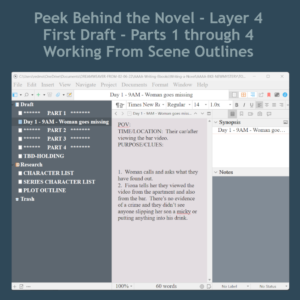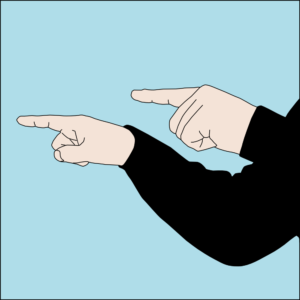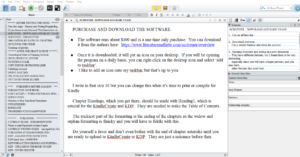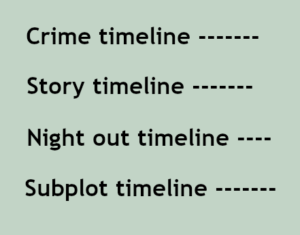LAYER 4 - WRITING THE FIRST DRAFT

- Use the Scene outlines to write the individual scenes.
- Split Scrivener Binder into Four Parts representing the Four Part Structure.
- I copy each scene outline into one document under the Part it belongs in.
- I set up all of my scene documents in the proper sections. I don't worry if certain parts are 'heavy'. The clues are recorded but the rest of the drama of the story is not.
THE MIND IS ALWAYS WORKING:
- This process will give you a bird's eye view of the scenes.

- I usually decide to move a scene or two closer to the mid-section of the story. Because it's only an outline, it's easy-peasy.
- By seeing the scenes with the timings and a one to three word prompt, I start to see the story from above.
I DON'T FORGET MY LANDMARKS - PART 1
- The Hook (Which we haven't talked about yet)
- The crime scene or the acknowledgement of the mystery
- The Inciting Incident - When the detectives start off to solve the crime.
- By the end of Part 1, I want there to be at least 2 suspects or even 3.
- By the end of Part 1, more than one person looks guilty.
LANDMARKS OF PART 2:
- Interviews begin - they point to different people
- Clues begin to trickle in - they may seem to clear one or another
- One of two secrets are exposed in Part 2.
- The end of Part 2 is the midway point. There could be a big surprise or shock
LANDMARKS OF PART 3:
- More interviews
- More clues
- Even the rise of another suspect, an unusual suspect.
- This rise of an unusual suspect can twist the story into another direction.
- This midway point could also be a Dark Night of the Soul where it may seem that the culprit may get away with it or it won't be solved or solved in time.
LANDMARKS OF PART 4:
- The first part of this section will be a big reveal.

- The crime will be solved between the start of Part 4 up to 2/3 of the part.
- There needs to be time to wrap up the crime and show how it affects everyone involved.
- The last part of the story is for the 'wrap up' where you tie up all the loose ends.
ABOUT WRITING THE WRAP UP:
- Reveal the guilty party and solve the mystery.
- Reveal why the red herring couldn't be guilty.
- Do a quick review of the whole crime to confirm for the readers
- Show a 'new normal' for the main characters, showing their character arcs completing.
- In a series, you need to drop a clue that this crime is finished but their story continues.
TIPS ON WRITING A FIRST DRAFT:
 Write forward only. Don't look back.
Write forward only. Don't look back.- Don't worry about spelling, grammar, verb tense, too many over-used words.
- The goal of the first draft is to get it down on paper and make sure you put everything into the story from your scene outlines.
- Think of it as 'blurting out the story'.
I'LL BE BUSY OVER THE NEXT FEW WEEKS WRITING:
- I've reached Layer 4 in my present novel. This layer takes time to get it all down on paper.
- By not worrying about prose or grammar, I'm free to just be creative about the story and whatever dialogue pops into my head.
- The first draft will be just that -- a first draft.
- Rest assured that the first draft is important, but by the time I get all the way to Layer 8, it will be polished and not look anything like it looks in the first draft.
I HOPE THIS SPURS SHARING
- I hope my revelations of my writing techniques will prompt other authors to reveal their process.
- I love to learn new techniques and when I was brand new, learning from experienced authors was so very helpful.
- Be sure to sign up at ReadFirstChapter.com to get on my mailing list. I send book promotions once a week and notices of new books and notices of when my books go "free" on Amazon.
Here is the YouTube video that goes along with this blog post. I have the timestamps below in case you want to watch a certain part over or just skip to the relevant part.
00:01 - How I set up Scrivener into the Four Part Story Structure 01:15 - This process gives you a bird's eye view of the entire story
02:00 - Showing in Scrivener how I set up the Binder, the documents, the Title and Synopsis sections and how I can use the Outline view to see a bird's eye view of the entire manuscript as it comes together.
03:00 - Tracking case time and personal time in order to weave in the subplots
03:36 - How I use the screen outlines, moving the scene outline into the Notes section to keep it safe
04:25 - The Corkboard vs. Outline View 06:10 - Keeping the writing landmarks of Part 1 in mind: The hook, inciting incident, etc.
07:15 - Landmarks of Part 2, how the evidence trickles in - middle of the book
08:20 - Landmarks of Part 3 - Names the suspects and a dark night of the soul.
09:20 - First half of Part 4 - The big reveal and the wrap up of the mystery. 11:03 - Tying up all loose ends and the subplots. Showing the new normal. Ending the character arcs for this story.
12:00 - Writing series and letting the reader know the crime has been solved but their personal lives continue.
12:37 - Five tips to Beginner Writers 13:30 - The story crafter vs. the story author.





